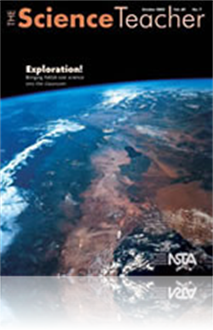All Resources
Journal Article
Student Teaching Tools: Key factors to remember in the classroom
Upon starting the actual process of teaching you can never be completely prepared for the experience. This author identifies four key factors that will help you through student teaching: organization, confidence, balance, and patience. Ideas on how t...
Journal Article
The Alien Lab: A Study in Genetics
Integrate language arts, mathematics, and art with this creature-building activity. Students reinforce their understanding of basic principles of heredity by creating alien creatures with specific traits. ...
Journal Article
Celebrate Earth Science Week with an exploration of the water cycle and our planet's limited liquid assets. This article, and the poster from the American Geological Institute, supports the theme—Water Is All Around Us. Students are encouraged to...
Journal Article
Crack open an acorn and investigate the organisms that call it home. In this article, students practice measurement skills as they conduct investigations and discuss concepts of habitat, communities, and ecosystem dynamics. Assessment ideas, extensio...
Journal Article
Probing for Understanding: Measuring scientific achievement with assessment probes
Measuring whether students have a deep understanding of scientific concepts is a challenge for educators. Using assessment probes allows inquiry into the meaning of deep understanding. The author shares several probes designed to research and gather ...
Journal Article
Commentary: Supporting the Student Teacher
An opinion piece about how the cooperating teacher continues to be the major influence on the student teacher. ...
Journal Article
Science and Children’s editor shares thoughts regarding the current issue....
Journal Article
Editor's Corner: Training Grounds for the Future
Training student teachers is a critical skill. The Science Teacher’s editor shares thoughts on student teaching....
Journal Article
Commentary: Why We Accept the Challenge
An opinion piece about qualified teachers serving as mentors to pre-service science teachers....
Journal Article
Tech Trek: Celestial observation tools
This activity—where students estimate the orbits of the four innermost moons of Jupiter through direct observation—represents a practical example of how teachers can use technology to explore celestial objects....
Journal Article
Hands-On Homework for Introductory Science
The author and colleagues have designed an Exploration Center to supplement lecture-oriented teaching in large introductory physics courses. At the center, students perform hands-on homework problems derived from lecture demonstrations. The style of ...
Journal Article
Seeing Isn't Always Believing: Investigating the reliability of classroom demonstrations
The author describes a traditional classroom experiment often used to demonstrate the amount of oxygen in the atmosphere, and challenges the high school chemistry students to test the validity of the procedure. Together they developed a way to deter...
Journal Article
Science Sampler: Five guiding principles of meteorology
The language of meteorology could be reduced to five deceptively simple guiding principles. This article focuses on how these guiding principles provide students with the necessary language to understand and make connections between concepts in meteo...
Journal Article
Exploration Science: A case history from Earth orbit
The intent of this case history is to encourage science fair organizers to permit students to submit observational science projects, not just experimental ones. The author shares a condensed example of his own research to illustrate the interplay of ...
Journal Article
This article describes an activity in which upper elementary students created “stream profiles” of an imaginary aquatic environment using science, mathematics, and simple materials. After the simulation, they applied what they learned during a fi...





